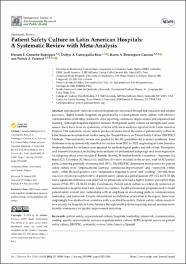Mostrar el registro sencillo del ítem
Patient Safety Culture in Latin American Hospitals: A Systematic Review with Meta-Analysis
| dc.contributor.author | Camacho-Rodríguez, Doriam E | es_ES |
| dc.contributor.author | Carrasquilla-Baza, Deibys A | es_ES |
| dc.contributor.author | Dominguez-Cancino, Karen A | es_ES |
| dc.contributor.author | Palmieri, Patrick A | es_ES |
| dc.date.accessioned | 2023-02-14T19:37:19Z | |
| dc.date.available | 2023-02-14T19:37:19Z | |
| dc.date.issued | 2022-11-03 | |
| dc.identifier.uri | https://hdl.handle.net/20.500.13053/7790 | |
| dc.description.abstract | “Introduction: Adverse events in hospitals are prevented through risk reduction and reliable processes. Highly reliable hospitals are grounded by a robust patient safety culture with effective communication, leadership, teamwork, error reporting, continuous improvement, and organizational learning. Although hospitals regularly measure their patient safety culture for strengths and weaknesses, there have been no systematic reviews with meta-analyses reported from Latin America. Purpose: Our systematic review aims to produce evidence about the status of patient safety culture in Latin American hospitals from studies using the Hospital Survey on Patient Safety Culture (HSOPSC). Methods: This systematic review was guided by the JBI guidelines for evidence synthesis. Four databases were systematically searched for studies from 2011 to 2021 originating in Latin America. Studies identified for inclusion were assessed for methodological quality and risk of bias. Descriptive and inferential statistics, including meta-analysis for professional subgroups and meta-regression for subgroup effect, were calculated. Results: In total, 30 studies from five countries-Argentina (1), Brazil (22), Colombia (3), Mexico (3), and Peru (1)-were included in the review, with 10,915 participants, consisting primarily of nursing staff (93%). The HSOPSC dimensions most positive for patient safety culture were ““organizational learning: continuous improvement““ and ““teamwork within units““, while the least positive were ““nonpunitive response to error““ and ““staffing““. Overall, there was a low positive perception (48%) of patient safety culture as a global measure (95% CI, 44.53-51.60), and a significant difference was observed for physicians who had a higher positive perception than nurses (59.84; 95% CI, 56.02-63.66). Conclusions: Patient safety culture is a relatively unknown or unmeasured concept in most Latin American countries. Health professional programs need to build patient safety content into curriculums with an emphasis on developing skills in communication, leadership, and teamwork. Despite international accreditation penetration in the region, there were surprisingly few studies from countries with accredited hospitals. Patient safety culture needs to be a priority for hospitals in Latin America through health policies requiring annual assessments to identify weaknesses for quality improvement initiatives.“ | es_ES |
| dc.format | application/pdf | es_ES |
| dc.language.iso | eng | es_ES |
| dc.publisher | MDPI | es_ES |
| dc.rights | info:eu-repo/semantics/openAccess | es_ES |
| dc.rights.uri | https://creativecommons.org/licenses/by/4.0/ | es_ES |
| dc.subject | HSOPSC; Latin America; SOPS; Spanish; communication; hospital survey on patient safety culture; hospitals; leadership; organizational culture; patient safety; quality improvement; staffing; surveys on patient safety culture; systematic review; teamwork. | es_ES |
| dc.title | Patient Safety Culture in Latin American Hospitals: A Systematic Review with Meta-Analysis | es_ES |
| dc.type | info:eu-repo/semantics/article | es_ES |
| dc.identifier.doi | 10.3390/ijerph192114380 | es_ES |
| dc.type.version | info:eu-repo/semantics/publishedVersion | es_ES |
| dc.publisher.country | CH | es_ES |
| dc.subject.ocde | http://purl.org/pe-repo/ocde/ford#3.03.00 | es_ES |
Ficheros en el ítem
Este ítem aparece en la(s) siguiente(s) colección(es)
-
Web of Science (WOS) [236]


